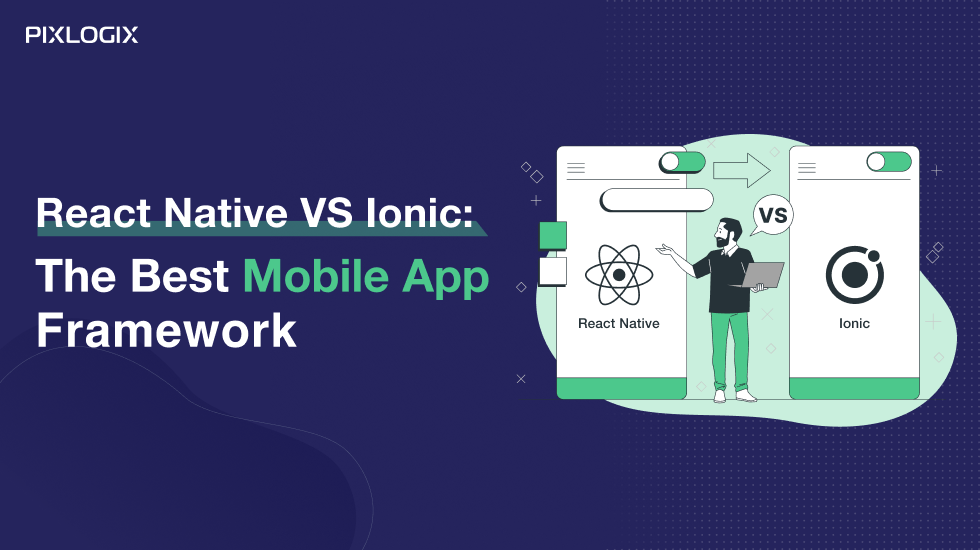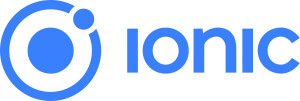React Native vs Ionic: The Best Mobile App Framework

- Last Updated On September 30, 2024
- 15 min read
Want to develop a mobile app that will support your vision? This blog is a saver for you.
Selecting the right mobile app development framework is very important. This decision can make your mobile app a big hit or ruin your all development efforts.
Some businesses and beginner developers face many challenges in choosing the best mobile app framework. Because this will decide how much you will be able to convert your ideas into reality.
Remember that, to select a proper framework review:
- Advantages
- Disadvantages
- Performance
- Development Capabilities
- Code Reusability
- UI/UX design possibilities
- Integration features
- Community support, etc.
In 2024, React Native vs Ionic is a big discussion. On group go with React Native and other support Ionic.
Well, each framework has unique features. Their capabilities are also developed for some specific project needs.
Read this, to compare React Native and Ionic features. This will help you to select the right framework by understanding which framework is suitable for your mobile app development needs. So let’s embark on the informative journey.
React Native
React Native, developed by Facebook, is an open-source framework that uses JavaScript and React to create cross-platform mobile applications. It has gained immense popularity due to its ability to deliver near-native performance and user experiences. React Native allows developers to write a single codebase that can be shared between iOS and Android platforms, significantly reducing development time and costs.
Advantages of React Native
We will delve into the numerous advantages of React Native that make it a preferred framework for modern app development.
#1: Cross-platform Development
One of the key advantages of React Native is its ability to facilitate cross-platform development. With a single codebase, developers can build apps that work seamlessly on iOS devices and Android platforms. This not only saves time and effort but also allows businesses to reach a wider audience, as the app can be launched on multiple platforms simultaneously.
#2: Reusability of Code
The concept of “write once, use anywhere” perfectly fits with React Native. The framework allows developers to reuse a significant portion of the code across different platforms. By sharing a common codebase, development becomes more efficient, maintenance is easier, and updates can be rolled out faster.
#3: Native-like Performance
React Native’s architecture enables it to render components using native APIs directly, providing an almost indistinguishable performance from native apps. By using native components, React Native ensures smooth and responsive user experiences, making it an attractive choice for resource-intensive applications.
#4: Hot Reloading
The hot reloading feature in React Native is a developer’s delight. It allows real-time code changes without the need to restart the app. This feature significantly accelerates the development process, as developers can instantly view the changes they make, enhancing productivity and reducing debugging time.
#5: Cost-Effectiveness
For businesses aiming to launch on multiple platforms, React Native proves cost-effective due to its code reusability and faster development cycles. The ability to have a single development team working on both platforms reduces development costs, making it an attractive option for startups and small to medium-sized enterprises.
React Native’s advantages make it an exceptional choice for modern mobile app development. As businesses continue to seek faster, cost-effective, and more efficient app development solutions, React Native remains a top contender for building cutting-edge mobile applications. Now, let’s understand the Ionic mobile App framework.
Ionic
Ionic is an open-source framework built on top of Angular and Apache Cordova. It utilizes web technologies like HTML, CSS, and JavaScript to create cross-platform mobile applications. Ionic provides a vast collection of pre-built UI components and plugins, making it an accessible choice for developers with web development backgrounds.
Advantages of Ionic
The advantages of the Ionic Mobile App framework for creating cross-platform mobile applications.
#1: Cross-Platform Compatibility
One of the most significant advantages of Ionic is its ability to create cross-platform applications with a single codebase. By using web technologies like HTML, CSS, and JavaScript, developers can build apps that seamlessly run on both iOS and Android platforms. This cross-platform compatibility not only reduces development time but also broadens the app’s reach to a wider audience.
#2: Rich UI Components
Ionic boasts an extensive collection of pre-designed UI components, providing developers with a wide array of ready-to-use elements. These components follow the native design guidelines for both iOS and Android, resulting in a visually appealing and consistent user interface. Developers can easily customize these components to match the app’s branding, saving valuable time on designing from scratch.
#3: Performance Optimization
Ionic leverages Apache Cordova and Capacitor’s power, allowing it to access native device features using JavaScript APIs. While most of the app’s interface is built using web technologies, Ionic efficiently handles native functionalities, leading to better performance and a more seamless user experience.
#4: Easy Learning Curve
Developers familiar with web development technologies such as HTML, CSS, and JavaScript can quickly adapt to Ionic. Its simplicity and ease of use contribute to a shallow learning curve, enabling developers to get up to speed and start building apps in no time. This accessibility makes Ionic a top choice for beginners and experienced developers alike.
#5: Rich Plugin Ecosystem
Ionic’s plugin ecosystem is vast and robust. It offers a wide range of plugins and extensions that developers can integrate effortlessly into their applications. Whether it’s adding geolocation, camera functionality, or push notifications, developers can easily extend the app’s capabilities using these plugins, saving time and effort on custom implementations.
Ionic’s advantages have solidified its position as a leading cross-platform mobile app development framework. With a vibrant community and continuous updates, Ionic remains at the forefront of app development technologies, empowering developers to build powerful and feature-rich apps with ease. Now, let’s see the detailed comparison of React Native vs Ionic.
Comparison between React Native vs Ionic
Performance
In 2024, both React Native and Ionic have solidified their positions as popular choices for cross-platform app development.
React Native
React Native is known for its ability to deliver near-native performance. It achieves this by utilizing a bridge that connects JavaScript code to native components, allowing it to render UI elements using native APIs directly. This approach ensures that the app behaves and performs almost like a native application, resulting in a smooth and responsive user experience.
Ionic
Conversely, Ionic relies heavily on web technologies such as HTML, CSS, and JavaScript. While it uses web views to render the app’s interface, certain complex animations and transitions might not be as performant as React Native. However, with advancements in Capacitor and web technologies, Ionic’s performance has improved over the years.
Verdict
React Native holds an advantage over Ionic in terms of performance.
Development Capabilities
Each framework comes with its own set of strengths and weaknesses, choosing between the two is dependent on specific project requirements and development team expertise.
React Native
React Native uses JavaScript, one of the most popular and widely adopted programming languages. JavaScript’s large community and extensive ecosystem provide developers with access to a vast array of libraries, tools, and resources, making development faster and more efficient.
Ionic
Ionic also utilizes JavaScript as its primary programming language. This language choice ensures that developers familiar with web development technologies can quickly adapt to Ionic app development. It also grants access to an extensive collection of web-based tools and resources.
Verdict
React Native provides more extensive development capabilities, especially for apps requiring native features.
Code Reusability
Both React Native and Ionic strive to provide efficient solutions for sharing code across platforms, enabling developers to easily build cross-platform applications.
React Native
React Native is well-known for its strong emphasis on code reusability. It enables developers to write a single codebase in JavaScript that can be shared between iOS and Android platforms. It promotes the creation of reusable components, which can be leveraged across different parts of the app or even across multiple projects.
This modularity allows developers to reduce redundant code and enhance development efficiency. While most of the codebase can be shared, React Native also allows developers to implement platform-specific code when necessary. This enables developers to fine-tune the app’s behavior and appearance on different platforms while still benefiting from a shared core.
Ionic
Ionic has also made strides in improving code reusability, though it follows a slightly different approach compared to React Native. Ionic primarily utilizes web technologies like HTML, CSS, and JavaScript.
This allows developers to leverage existing web development skills and resources, making it easier to share code across platforms. With Ionic, developers can create a single codebase that works across various platforms, including iOS, Android, and web browsers.
This code reusability significantly reduces development time and effort. Moreover, Ionic leverages platforms like Capacitor and Cordova to access native device functionalities. By using these platforms, developers can extend the app’s capabilities without sacrificing code reusability.
Verdict
React Native offers better code reusability compared to Ionic.
UX/UI
User experience and user interface are critical components of mobile app development, influencing how users interact with and perceive an application.
React Native
React Native provides a rich set of pre-built, platform-specific UI components that closely mimic native elements. This results in an app that feels familiar to users on both iOS and Android, contributing to a seamless and intuitive user experience.
While React Native offers platform-specific components, customization might require additional effort. Developers can use custom styles and themes to match the app’s branding, but achieving a fully native look and feel might require additional work.
Ionic
Ionic focuses on providing consistent and visually appealing UI components across platforms, making creating attractive and functional apps easier. It offers a comprehensive set of cross-platform UI components that adhere to iOS and Android design guidelines.
This ensures a consistent look and feel across different platforms, simplifying the development process. Additionally, Ionic’s web-based nature allows for easy customization using standard web technologies like CSS. Developers can quickly tailor the app’s appearance to match the desired branding or design requirements.
Verdict
React Native offers a more authentic native experience.
Community Support
The strength of a development framework lies not only in its features and capabilities but also in the support it receives from its community and the ecosystem that surrounds it.
React Native
React Native enjoys an extensive and vibrant community of developers and contributors. The framework’s popularity has led to a large user base, which means that developers can find plenty of resources, tutorials, and answers to common issues from the community. The community actively participates in discussions, shares best practices, and contributes to the continuous improvement of the framework.
Ionic
Ionic also boasts a strong and growing community of developers, though it might not be as extensive as React Native’s community. Nevertheless, the community is actively engaged, and developers can find valuable resources and support from various online forums, social media groups, and official documentation.
Verdict
React Native enjoys better community support and ecosystem.
Integration with Native Features
The ability to access and utilize native device features is crucial for mobile app development, as it enables developers to create more powerful and feature-rich applications.
React Native
React Native has a robust approach to integrating with native features through its “bridging” mechanism. It allows developers to access platform-specific native APIs directly from JavaScript code. This direct access to native modules ensures that developers can leverage all the capabilities provided by the underlying operating system and hardware.
Ionic
Ionic integrates with native features using Capacitor and Cordova. Capacitor is a native runtime for web applications, while Cordova is a well-established platform for bridging web applications to native features. Both tools allow developers to access native APIs and hardware functionalities.
Verdict
React Native offers more efficient integration with native features.
Conclusion
React Native and Ionic continue to be popular choices for cross-platform mobile app development.
Samir Bhimbha
Samir Bhimbha is the Founder & CEO of Pixlogix Infotech Pvt. Ltd. which offers web and app solutions to fulfill business's online needs and help to improve their online presence with many clients in the USA, Europe, Australia, and more. He is a skilled entrepreneur, web designer, developer, and team leader who can handle every situation. With 15+ years of experience in UX/UI design and web development, he is leading a team of IT professional talents.
Related Post
Get in Touch Now!
Have a word with our expert consultants about your next project to get suggestive guidance & proposal.
Sales Inquiry
Chat with us about your project for a custom solution and quote.













